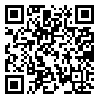Volume 20, Issue 64 (4-2019)
Zanko J Med Sci 2019, 20(64): 84-91 |
Back to browse issues page
Download citation:
BibTeX | RIS | EndNote | Medlars | ProCite | Reference Manager | RefWorks
Send citation to:



BibTeX | RIS | EndNote | Medlars | ProCite | Reference Manager | RefWorks
Send citation to:
Morphometry of Important landmark in the base of the skull and its clinical significance . Zanko J Med Sci 2019; 20 (64) :84-91
URL: http://zanko.muk.ac.ir/article-1-417-en.html
URL: http://zanko.muk.ac.ir/article-1-417-en.html
Abstract: (3836 Views)
Background and Aim: knowledge about bony landmarks at the base of the skull is useful for neurologists doing surgical procedures to access brain stem or paravertebral tumors. In addition, it causes valuable information in some cases, such as Wernet's syndrome or Willart’s syndrome. Currently, textbooks are according to anthropometric values from Western countries. Appointing national anthropometric measurements is one of the research priorities in our country. Therefore, the purpose of this study was to investigate the morphometry of the hypogloss canal, occipital condyles and jugular foramen in dry skulls.
Material and Method: In this study, morphometric indexes of 41 dry skulls from Abadan, Tehran, Mashhad, Gonabad, Birjand and Isfahan universities were studied. Length, width, height of the condyles, their anterior and posterior distance together, the angle of the condyles, their anterior and posterior distance with the hypoglossal channel and the jugular foramen were measured. In addition, the presence of complete or incomplete septum was investigated in the hypoglossal channel and jugular foramen. Finally, the data were analyzed using SPSS software version 21 and descriptive statistics
Results: The mean length of the occipital condyle was 2.4±0.39 cm, the mean width of the occipital condyle was 1.1±0.22 cm and their height was between 0.8±0.3 cm. The mean anterior distance of the condyles was 2.1±0.38 cm and the posterior condyles were 4.1±0.7 cm. In addition, the mean angles of the condyles with the middle line were 53±10.55 degrees. The mean posterior diameter of the jugular foramen was 1.4±0.36 cm and the transverse diameter was 1.2±0.23 cm. The percentage of incomplete septum in the hypoglossal canal was 9.7% and in the Jugular foramen, it was 17.07%.
Conclusion: Measuring the morphometric landmarks of the skull bones can be helpful for brain surgeons, anthropologists and anatomists. The results of this study showed that the landmarks of the base skull are near to Asian population, especially India and Bangladesh. Dear researchers, more morphometric studies are recommended on skull bones, as well as CT scans and MRI images with a large sample size in different ethnic groups.
Material and Method: In this study, morphometric indexes of 41 dry skulls from Abadan, Tehran, Mashhad, Gonabad, Birjand and Isfahan universities were studied. Length, width, height of the condyles, their anterior and posterior distance together, the angle of the condyles, their anterior and posterior distance with the hypoglossal channel and the jugular foramen were measured. In addition, the presence of complete or incomplete septum was investigated in the hypoglossal channel and jugular foramen. Finally, the data were analyzed using SPSS software version 21 and descriptive statistics
Results: The mean length of the occipital condyle was 2.4±0.39 cm, the mean width of the occipital condyle was 1.1±0.22 cm and their height was between 0.8±0.3 cm. The mean anterior distance of the condyles was 2.1±0.38 cm and the posterior condyles were 4.1±0.7 cm. In addition, the mean angles of the condyles with the middle line were 53±10.55 degrees. The mean posterior diameter of the jugular foramen was 1.4±0.36 cm and the transverse diameter was 1.2±0.23 cm. The percentage of incomplete septum in the hypoglossal canal was 9.7% and in the Jugular foramen, it was 17.07%.
Conclusion: Measuring the morphometric landmarks of the skull bones can be helpful for brain surgeons, anthropologists and anatomists. The results of this study showed that the landmarks of the base skull are near to Asian population, especially India and Bangladesh. Dear researchers, more morphometric studies are recommended on skull bones, as well as CT scans and MRI images with a large sample size in different ethnic groups.
Type of Study: Research |
Subject:
General
Received: 2018/07/15 | Accepted: 2018/11/16 | ePublished: 2019/04/15
Received: 2018/07/15 | Accepted: 2018/11/16 | ePublished: 2019/04/15
| Rights and permissions | |
 |
This work is licensed under a Creative Commons Attribution-NonCommercial 4.0 International License. |



